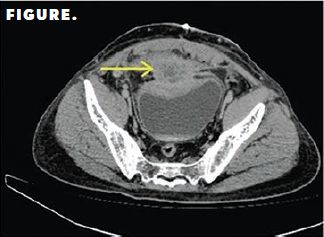Article
Presentation, diagnosis, and management of a rare case of urachal adenocarcinoma
"Urachal carcinoma is a rare and aggressive malignancy. The low incidence of the disease results in limited large-scale clinical trials that could provide standardized guidelines for its diagnosis and management," write Christopher Pieczonka, MD, and Peter Fioramonti, BS.
A 56-year-old Caucasian woman presents to her urologist with gross hematuria and a nontender infraumbilical mass approximately 3 cm in size. There is no drainage from the umbilicus. In-office cystoscopy suggests a mass effect to the dome of the bladder and friable mucosa. Representative CT imaging as shown in Figure.

During the first trimester of prenatal development, urine drains from the fetal bladder through the allantois that exits the umbilicus. This channel closes at the umbilical end during the second trimester to form a remnant hollow tube between the bladder and the umbilicus, known as the urachus.1 Typically, the urachus closes and elongates to form a fibrous cordlike structure running along the retropubic space, connecting the apex of the bladder to the umbilicus. Disruption of the closure of the urachus can result in a series of uncommon congenital urachal anomalies known as urachal remnant diseases, such as a patent urachus, umbilical polyp, bladder diverticulum, or urachal cyst. These anomalies are usually asymptomatic, but they can present early in life with symptoms such as drainage from the umbilicus, redness around the umbilicus, or abdominal pain.2 Although asymptomatic congenital urachal anomalies are usually discovered incidentally from CT or MRI studies performed for other reasons, they also can be evaluated based on their type via ultrasonography, cystography, sonography, or cystoscopy.3
In cases where congenital urachal anomalies persist through adulthood, the urachal remnant may cause complications, such as infections or neoplasms. Infections are the most common complication of urachal remnants and may present with nonspecific symptoms such as abdominal tenderness, fever, pyuria, erythema, and sometimes a palpable mass.2 In this patient, a rare case of urachal adenocarcinoma was the diagnosis. Although urachal remnants are lined by urothelium, 80% of urachal cancers are adenocarcinomas. The remaining 20% of urachal cancers are urothelial, squamous, and sarcomatoid neoplasms.3-5 Urachal cancers are highly aggressive malignancies with a 5-year cancer-specific survival rate of less than 60%, and account for less than 1% of bladder cancers.6-8 The poor prognosis for patients with urachal carcinoma is partly a result of the low incidence of malignant urachal neoplasms, which has hindered the implementation of large-scale clinical studies that could provide evidence to create guidelines for the diagnosis and treatment of these rare malignancies. Currently, no standardized guidelines exist for the management of malignant urachal neoplasms.6,7
Diagnostic evaluation
The initial manifestation and presentation of urachal carcinoma shares several similarities with urothelial carcinoma. For example, hematuria, suprapubic pain, and voiding difficulties such as urinary frequency, urinary urgency, dysuria, and urge incontinence are observed in 82%, 24%, and 12% of patients, respectively.7 The risk for urachal carcinoma is also higher in males and in patients older than 55 years.6,7 Signs and symptoms unique to patients with urachal carcinoma include the presence of a palpable infraumbilical mass or mucosuria, both observed in 9% of patients.7
Although the criteria for the diagnosis of urachal carcinoma are still somewhat controversial, most investigators agree with those set forth by Sheldon and Mostofi. These include:
location in the dome or anterior wall of the bladder;
sharp demarcation between the tumor and the normal surface epithelium;
lack of prominent cystitis glandularis in adjacent mucosa;
bulk of the tumor in the bladder wall rather than luminal;
presence of urachal remnants within the tumor; and
exclusion of primary adenocarcinoma located elsewhere that has spread secondarily to the bladder.9-11
Certain institutions believe these criteria are too restrictive and instead use the following diagnostic criteria proposed by Johnson:
location in the dome or elsewhere in the midline of the bladder;
sharp demarcation between the tumor and the surface epithelium; and
absence of primary adenocarcinoma of another organ.4,12
Diagnostic techniques performed during the diagnosis of urachal carcinoma include cystoscopy, CT urography (CTU), ultrasonography, MRI, and endoscopic biopsy. In this case, in which a nonpregnant 56-year-old woman without acute kidney injury or findings suggestive of glomerular bleeding presents with gross hematuria, the patient should receive a CTU and cystoscopy. The combination of CTU and cystoscopy provides a complete evaluation of the urinary system and can be used to identify the location of the tumor and rule out other malignancies.13,14 Additional imaging findings indicative of urachal carcinoma include the presence of a solid urachal mass or a mass with macroscopic calcification, which occurs in 50% and 35% of urachal carcinomas, respectively.7,15,16 Finally, a transurethral biopsy is required to collect a tumor sample for use in subsequent histological studies.7,17,18
Management
Given the rare nature of the disease, there are no standardized guidelines for the treatment of malignant urachal neoplasms, and knowledge about this disease is primarily derived from case reports and single-institution case series.6,7 The primary treatment for urachal carcinoma is total urachectomy in conjunction with partial cystectomy, which entails the excision of the bladder dome and urachal remnant along with the peritoneal, fascial, and umbilical segments to ensure adequate surgical margins. Although partial cystectomy is not considered standard of care for urothelial bladder cancer, urachal cancer-specific survival rates are similar in those treated with radical cystectomy and partial cystectomy.7,15,19,20 Furthermore, the most influential predictors of urachal cancer-specific survival are umbilectomy status, surgical margins, and tumor grade. Despite surgical improvements, urachal adenocarcinoma has a reported recurrence rate between 20% and 38%.7,21 Half the recurrences occur locally, usually following partial cystectomy, and tend to occur within the first 6 to 24 months after surgery.15 Nevertheless, repeat surgical resection following local recurrence has demonstrated a 15-year cure rate of 67%.7
Radiotherapy and chemotherapies are rarely used in a neoadjuvant or adjuvant setting, and their efficacy remains unclear due to the lack of published data. Additional treatment options are used to treat unresectable or metastatic urachal carcinomas. As is the case with urothelial carcinomas of the bladder, radiotherapy is scarcely implemented in the treatment of urachal carcinoma and is likely an underutilized tool as we move toward bladder-preserving management. Additional case studies and large-scale case series are needed to assess the efficacy of radiotherapy regimens for urachal carcinomas. Furthermore, without access to standardized chemotherapeutic protocols for the management of urachal carcinoma, treating physicians are responsible for defining the best therapeutic strategies for their patients.17,22,23 This task is complicated by the lack of published findings from studies on the efficacy of different treatments. Currently, the cisplatin-based combination therapies are believed to be the optimal treatment of urachal carcinoma.8,17 Interestingly, urachal carcinomas have been shown to have similar histological and molecular profiles to those of colorectal adenocarcinoma. Thus, the same chemotherapy regimens are often used for the treatment of urachal carcinoma and colorectal cancer.8,15
Urachal carcinoma is a rare and aggressive malignancy. The low incidence of the disease results in limited large-scale clinical trials that could provide standardized guidelines for its diagnosis and management. Despite this obstacle, physicians can derive insight from the available case studies and large-scale case series that provide data on this rare disease. Although the criteria for urachal carcinoma diagnosis are controversial, diagnoses typically involve cystoscopy and a CT urogram to characterize the localization of the tumor, other necessary imaging studies to rule out the possibility of other primary adenocarcinomas, and transurethral biopsy for pathologic examination. The primary mainstay treatment for urachal carcinoma is the surgical removal of the bladder dome and the urachal remnant along with the peritoneal, fascial, and umbilical segments. More case studies and large-scale case series are necessary to determine the efficacy of radiotherapy and chemotherapies in neoadjuvant, adjuvant, and metastatic settings. •
References
1. Sadler TW. Langman’s Medical Embryology. 14th ed. Wolters Kluwer; 2019.
2. What are urachal abnormalities? Urology Care Foundation. Accessed February 20, 2022. http://www.urologyhealth.org/urologic-conditions/urachal-abnormalities
3. Parada Villavicencio C, Adam SZ, Nikolaidis P, Yaghmai V, Miller FH. Imaging of the urachus: anomalies, complications, and mimics. Radiographics. 2016;36(7):2049-2063. doi:10.1148/rg.2016160062
4. Dhillon J, Liang Y, Kamat AM, et al. Urachal carcinoma: a pathologic and clinical study of 46 cases. Hum Pathol. 2015;46(12):1808-1814. doi:10.1016/j.humpath.2015.07.021
5. Wong-You-Cheong JJ, Woodward PJ, Manning MA, Davis CJ. From the archives of the AFIP: inflammatory and nonneoplastic bladder masses: radiologic-pathologic correlation. Radiographics. 2006;26(6):1847-1868. doi:10.1148/rg.266065126
6. Mylonas KS, O’Malley P, Ziogas IA, El-Kabab L, Nasioudis D. Malignant urachal neoplasms: a population-based study and systematic review of literature. Urol Oncol. 2017;35(1):33.e11-33.e19. doi:10.1016/j.urolonc.2016.07.021
7. Ashley RA, Inman BA, Sebo TJ, et al. Urachal carcinoma: clinicopathologic features and long-term outcomes of an aggressive malignancy. Cancer. 2006;107(4):712-720. doi:10.1002/cncr.22060
8. Mennitto A, Vernieri C, Procopio G. Urachal carcinoma: towards a precision medicine. Transl Cancer Res. 2016;5(suppl 7):S1307-S1310. doi:10.21037/tcr.2016.12.28
9. Gopalan A, Sharp DS, Fine SW, et al. Urachal carcinoma: a clinicopathologic analysis of 24 cases with outcome correlation. Am J Surg Pathol. 2009;33(5):659-668. doi:10.1097/PAS.0b013e31819aa4ae
10. Sheldon CA, Clayman RV, Gonzalez R, Williams RD, Fraley EE. Malignant urachal lesions. J Urol. 1984;131(1):1-8. doi:10.1016/S0022-5347(17)50167-6
11. Mostofi FK, Thomson RV, Dean AL Jr. Mucous adenocarcinoma of the urinary bladder. Cancer. 1955;8(4):741-758. doi:10.1002/1097-0142(1955)8:4<741::aid-cncr2820080417>3.0.co;2-c
12. Johnson DE, Hodge GB, Abdul-Karim FW, Ayala AG. Urachal carcinoma. Urology. 1985;26(3):218-221. doi:10.1016/0090-4295(85)90112-8
13. O’Connor OJ, McSweeney SE, Maher MM. Imaging of hematuria. Radio Clin North Am. 2008;46(1):113-132. doi:10.1016/J.RCL.2008.01.007
14. Gray Sears CL, Ward JF, Sears ST, Puckett MF, Kane CJ, Amling CL. Prospective comparison of computerized tomography and excretory urography in the initial evaluation of asymptomatic microhematuria. J Urol. 2002;168(6):2457-2460. doi:10.1097/01.ju.0000036541.52816.98
15. Claps M, Stellato M, Zattarin E, et al. Current understanding of urachal adenocarcinoma and management strategy. Curr Oncol Rep. 2020;22(1):9. doi:10.1007/s11912-020-0878-z
16. Chen D, Li Y, Yu Z, et al. Investigating urachal carcinoma for more than 15 years. Oncol Lett. 2014;8(5):2279-2283. doi:10.3892/ol.2014.2502
17. Wilson AL, Gandhi J, Seyam O, et al. Urachal anomalies: a review of pathological conditions, diagnosis, and management. Translational Research in Anatomy. 2019;16:100041. doi:10.1016/j.tria.2019.100041
18. Thirunavukkarasu B, Mridha AR, Yadav S, Kumar R, Gamanagatti S. Fine needle aspiration cytology diagnosis of an urachal adenocarcinoma. J Clin Diagn Res. 2016;10(4):ED10-ED12. doi:10.7860/JCDR/2016/16115.7586
19. Milhoua PM, Knoll A, Bleustein CB, Ghavamian R. Laparoscopic partial cystectomy for treatment of adenocarcinoma of the urachus. Urology. 2006;67(2):423.e15-423.e17. doi:10.1016/j.urology.2005.08.044
20. Krane LS, Kader AK, Levine EA. Cytoreductive surgery with hyperthermic intraperitoneal chemotherapy for patients with peritoneal carcinomatosis secondary to urachal adenocarcinoma. J Surg Oncol. 2012;105(3):258-260. doi:10.1002/jso.22081
21. Siefker-Radtke A. Urachal adenocarcinoma: a clinician’s guide for treatment. Semin Oncol. 2012;39(5):619-624. doi:10.1053/j.seminoncol.2012.08.011
22. Paschke L, Juszczak M, Slupski M. Surgical treatment of recurrent urachal carcinoma with liver metastasis: a case report and literature review. World J Surg Oncol. 2016;14(1):296. doi:10.1186/s12957-016-1057-4
23. Zong L, Chen P. Surgical and chemotherapeutic experience regarding a urachal carcinoma with repeated relapse: case report and literature review. World J Surg Oncol. 2013;11:170. doi:10.1186/1477-7819-11-170

















